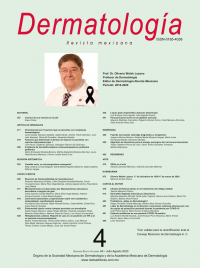Incidence of cortico-damaged atopic dermatitis in pediatric population.
Dermatol Rev Mex. 2020; 64 (4): 386-392.
María Enriqueta Morales-Barrera,1 Martha Alejandra Morales-Sánchez,1 Laura Nilda Moreno-Martínez,2 Fermín Jurado-Santa Cruz1
1 Centro Dermatológico Dr. Ladislao de la Pascua, Servicios de Salud Pública de la Ciudad de México.
2 Práctica privada.
Resumen
ANTECEDENTES: La dermatitis atópica es una enfermedad inflamatoria, crónica, de origen multifactorial, con incidencia de 3.25% en todo el mundo.
OBJETIVO: Detectar la incidencia de dermatitis atópica con datos clínicos de corticoestropeo en el Centro Dermatológico Pascua.
MATERIAL Y MÉTODO: Estudio transversal descriptivo en el que de 2009 a 2018 se buscaron los expedientes electrónicos de pacientes con dermatitis atópica y se determinaron las siguientes variables: sexo, edad, tiempo de evolución, tipo de esteroide administrado y duración del tratamiento; también se calculó la incidencia de dermatitis atópica costicoestropeada usando el programa SPSS versión 19.0.
RESULTADOS: Se identificaron 12,916 pacientes pediátricos con dermatitis atópica, 53% eran mujeres y 46.7% hombres. La incidencia fue de 2.4 a 4.74; del total, 2.4% (n = 304) tenían datos de corticoestropeo; 74% tenía el cuadro diseminado a más de un segmento corporal; 4.9% padecía eritrodermia al momento del diagnóstico; la mediana del tiempo de evolución fue de 2 años; 28.3% de los pacientes eran escolares; 96.3% aplicaron un esteroide tópico y 53.6% uno combinado.
CONCLUSIONES: Se encontró aumento de la incidencia de dermatitis atópica y de los casos de corticoestropeo en edad pediátrica. Las compañías farmacéuticas que comercializan esteroides tópicos deben cumplir con los programas de farmacovigilancia.
PALABRAS CLAVE: Dermatitis atópica; esteroide.
Abstract
BACKGROUND: Atopic dermatitis is an inflammatory, chronic disease of multifactorial origin, with an incidence of 3.25% worldwide.
OBJECTIVE: To determine the incidence of atopic dermatitis from clinical records from Centro Dermatológico Dr. Ladislao de la Pascua, Mexico City.
MATERIAL AND METHOD: A cross-sectional and descriptive study was done from 2009 to 2018 by reviewing electronic files of patients with atopic dermatitis; the following data were determined: sex, age, duration of the disease, type of steroid administered and duration of the treatment. The incidence of cortico-damaged atopic dermatitis was calculated using SPSS version 19.0.
RESULTS: We identified 12,916 pediatric patients with atopic dermatitis, 53% were women and 46.7% men; the incidence was 2.4 to 4.74; of the total, 2.4% (304) suffered cortico-damaged atopic dermatitis. Seventy four percent of the patients developed disseminated disease with extent to more than one body segment; 4.9% had erythroderma at the time of diagnosis; the median evolution time was 2 years; 28.3% of the patients were schoolchildren; 96.3% applied a topical steroid and 53.6% (n = 163) a combined steroid.
CONCLUSIONS: An increase in the incidence of atopic dermatitis and in cases of pediatric cortico-damaged atopic dermatitis was found. Pharmaceutical companies that sell topical steroids must comply with pharmacovigilance programs.
KEYWORDS: Atopic dermatitis; Steroid.

